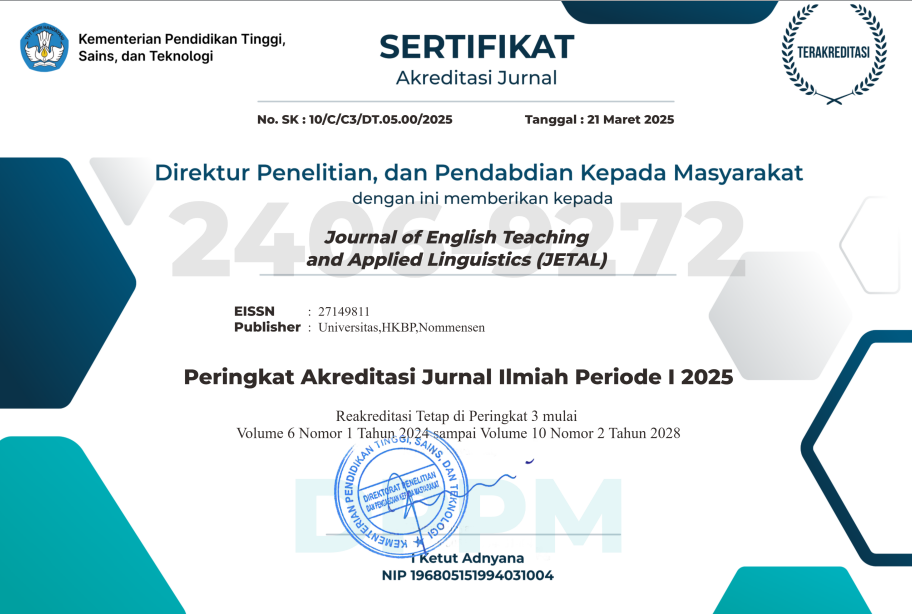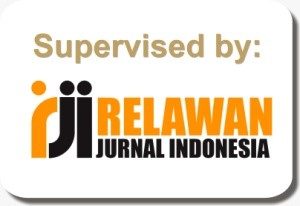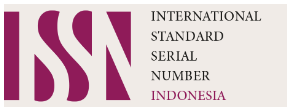STUDENTS PERCEPTION ABOUT GOOGLE TRANSLATE AS MEDIA FOR TRANSLATING ENGLISH DESCRIPTIVE
Abstract
The aim of this study to know students’ perception of Google Translate as Media for Translating English Descriptive Text at Fifth Semester of English Department Nommensen HKBP University. Questionnaires which formulated in google form are formulated as instrument to collect students’ responds on the usage of google translate in translating source to target. The questionnaire sheet consists of twelve questions about students’ perception of Google Translate as media for translating English descriptive text. The source of data in this study was taken by the fifth-semester student of English Department. There are twenty students have been filled the questionnaire sheet. This study was applied a descriptive qualitative design. The findings from the data analysis, Students have different positive and negative perception about Google Translate as media for translating English descriptive text. Students really like using Google translate as media for translating English descriptive text because make students easier. Students can translate text faster than open a dictionary. Google translate help students improve vocabulary with good intonation. They feel happy because it is easier to use but Google translate incorrect to translate in level of sentence. Based on their perceptions state that Google translate can be used as an alternative ways in teaching and learning activities.
References
Andren, L., Papp, D., Penno, E., & Vallas, A. (2015). Making Sense of Functional Grammar. Eesti Teadusliku Seltsi Rootsis : Aastaraamat. Annales Societatis Litterarum Estonicae in Svecia, 11, 216. https://openlibrary.telkomuniversity.ac.id/home/catalog/id/104961/slug/maki ng-sense-of-functional-grammar.html
Garcia, I., & Pena, M. I. (2011). Machine translation-assisted language learning: writing for beginners. Http://Dx.Doi.Org/10.1080/09588221.2011.582687, 24(5), 471–487. https://doi.org/10.1080/09588221.2011.582687
Hardini, F., Dewi, R. C., & Dan Bisnis Indonesia, I. (2019). TACKLING THE NEGATIVE IMPACTS OF STUDENTS’ ADDICTION TO GOOGLE TRANSLATE.
Hidayah, R., Wangid, M. N., & Wuryandani, W. (2022). Elementary School Teacher Perception of Curriculum Changes in Indonesia. Pegem Egitim ve Ogretim Dergisi, 12(2), 77–88. https://doi.org/10.47750/pegegog.12.02.07
Irawati, I., Ningsi, F., STKIP Taman Siswa Bima, D., & Bima, K. (2022). Students’ Perception and Motivation toward English E-Learning during Covid-19 Pandemic of Eleventh Grade Students at SMAN 1 Monta. http://Jiip.stkipyapisdompu.ac.id
Irwanto; (2002). PSIKOLOGI UMUM : BUKU PANDUAN MAHASISWA. 8. //opac.pipsemarang.ac.id/index.php?p=show_detail&id=8267&keywords=
Josefsson, E., & Rheinholdsson, P. (2011). Contemporary Approaches to Translation in the Classroom : A study of students & apos; Attitudes and Strategies. 5. http://urn.kb.se/resolve?urn=urn:nbn:se:du-5929
Junining, E., Mahendra, V. A., Kusuma, C., Universitas, B., Malang, J., & Timur, I. (2020). TRANSLATION STRATEGIES FOR TRANSLATING A NEWS ARTICLE. In LiNGUA (Vol. 15, Issue 1).
Karisi, Y., Pelenkahu, N., & Maru, G. (2022). Students’ Perception Of The Use Of Youtube In Translation Class.
Maulida, H. (2017). Persepsi Mahasiswa Terhadap Penggunaan Google Translate Sebagai Media Menerjemahkan Materi Berbahasa Inggris. In Jurnal Saintekom (Vol. 7, Issue 1).
Newmark, P. (2014). Introduction to translations. In Journal of the American 42 Psychoanalytic Association (Vol. 62, Issue 1). https://doi.org/10.1177/0003065114525045
Nugroho, R. A., Basari, A., Suryaningtyas, V. W., & Cahyono, S. P. (2020). University students’ perception of online learning in Covid-19 pandemic : A case study in a translation course. Proceedings - 2020 International Seminar on Application for Technology of Information and Communication: IT Challenges for Sustainability, Scalability, and Security in the Age of Digital Disruption, ISemantic 2020, 225–231. https://doi.org/10.1109/iSemantic50169.2020.9234251
Poon, &, & Broadbent, J. (2015). Self-regulated learning strategies & academic achievement in online higher education learning environments: A systematic review. https://doi.org/10.1016/j.iheduc.2015.04.007
Pujiati, T. (2017). Pemanfaatan Google Translate dalam Penerjemahan Teks Bahasa Inggris ke dalam Bahasa Indonesia. Membangun Paradigma Kehidupan Melalui Multidisiplin Ilmu, 1, 58–61. http://openjournal.unpam.ac.id/index.php/Proceedings/article/view/766
Qiong. (2017). A Brief Introduction to Perception. Studies in Literature and Language, 15(4), 18–28. https://doi.org/10.3968/10055
Rakhmat, J. (2007). Psikologi komunikasi.bandung. remaja rosdakarya.https://opac.perpusnas.go.id/DetailOpac.aspx?id=681738
Rass, R. (2001). Integrating Reading and Writing for Effective Language Teaching. Undefined.
Sagita, M., & Balqis, N. (2021). STUDENTS’ PERCEPTION ABOUT GOOGLE TRANSLATION TOOL IN LEARNING ENGLISH (A Descriptive Study at Jabal Ghafur University). Getsempena English Education Journal (GEEJ, 8(1), 26.
Sipayung, K. T., Sianturi, N. M., Arta, I. M. D., Rohayati, Y., & Indah, D. (2021). Comparison of Translation Techniques by Google Translate and U-Dictionary: How Differently Does Both Machine Translation Tools Perform in Translating? Elsya : Journal of English Language Studies, 3(3), 236–245. https://doi.org/10.31849/elsya.v3i3.7517
Sobur. (2003). Psikologi umum / penulis, Drs. Alex Sobur, M.Si ; pengantar, Dr. O. Hasbiansyah, M.SI | UPT Perpustakaan Proklamator Bung Karno. http://inlislite.perpusbungkarno.perpusnas.go.id:12345/inlislite3/opac/detailopac?id=120824
Sugiyono.(2009). Metode Penelitian Kualitatif. https://scholar.google.com/scholar?hl=id&as_sdt=0%2C5&q=Sugiyono%2C+%282009%29%2C+Metode+Penelitian+Kuantitatif%2C+Kualitatif+dan+R%26D%2C+Bandung+%3A+Alfabeta&btnG=
Sylphiasimanjuntak, U., Silalahi, D. E., Sihombing, P. S. R., & Purba, L. (2021). Students’ Perceptions Of Using Youtube As English Online Learning Media During Covid-19 Pandemic. JOLLT Journal of Languages and Language Teaching, 9(2), 150. https://doi.org/10.33394/jollt.v%vi%i.3567
Tumbal, S., Liando, N. V. F., & Olii, S. T. (2018). Students’ Perceptions Toward the Use of Google Translate in Translating. 2009, 313–320.
Timothy, T., & Marietta Da Silva, A. (2018). Edulangue Teachers’ Perception Towards Video Conference For Remote Online Teaching: The Use Of Google Meet In Efl Elementary Classrooms. In Journal of English Language Education (Vol. 5, Issue 1). translation 2 (1). (n.d.).
Yanti, M., Martha Meka, L. C., Tanjung Nyaho, Ht., & Raya, P. (2019). The students’ perception in using Google Translate as a media in translation class. 14–16. http://e-proceedings.iain-palangkaraya.ac.id/index.php/inacelt
Authors retain copyright and grant the journal right of first publication with the work simultaneously licensed under a Creative Commons Attribution-ShareAlike 4.0 International License (CC BY-SA 4.0) that allows others to share the work with an acknowledgment of the work's authorship and initial publication in this journal.
Authors are able to enter into separate, additional contractual arrangements for the non-exclusive distribution of the journal's published version of the work (e.g., post it to an institutional repository or publish it in a book), with an acknowledgment of its initial publication in this journal.
Authors are permitted and encouraged to post their work online (e.g., in institutional repositories or on their website) prior to and during the submission process, as it can lead to productive exchanges, as well as earlier and greater citation of published work (See The Effect of Open Access).






